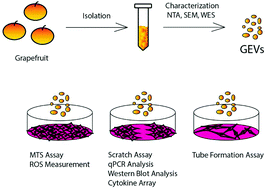Grapefruit-derived extracellular vesicles as a promising cell-free therapeutic tool for wound healing
Abstract
Due to the prevalence of individuals suffering from chronic wounds, developing safe and effective wound care agents are one of the more prominent fields of research in biology. However, wound healing is a complex, multi-stage biological process, involving multiple sequences of biological responses from different types of cells, secreted mediators, and extracellular matrix elements. Plants have a long history of use in the treatment of wounds. Plant-derived extracellular vesicles, which are secreted nano vesicle messengers responsible for intercellular communications, show promise as a new, biotechnological wound-care agent. In this study, we assessed the wound healing potential of extracellular vesicles isolated from grapefruits – a plant with well-known anti-inflammatory and wound healing properties. Grapefruit extracellular vesicles (GEVs) increased cell viability and cell migration while reducing intracellular ROS production in a dose-dependent manner in HaCaT cells. Expression of proliferation and migration-related genes were raised by GEV treatment in a dose dependent manner. Additionally, GEV treatment increased the tube formation capabilities of treated HUVEC cells. These findings suggest that GEVs can be used as plant-derived wound healing agents, and have shown potential as a biotechnological agent for wound healing. Further development and study of plant-derived extracellular vesicles may lead to the realization of their full potential.



 Please wait while we load your content...
Please wait while we load your content...